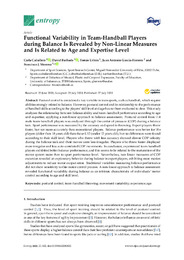Please use this identifier to cite or link to this item:
https://hdl.handle.net/11000/34266Full metadata record
| DC Field | Value | Language |
|---|---|---|
| dc.contributor.author | Caballero, Carla | - |
| dc.contributor.author | Moreno, Francisco Javier | - |
| dc.contributor.author | Barbado, David | - |
| dc.contributor.author | URBÁN INFANTES, TOMÁS | - |
| dc.contributor.author | García Herrero, Juan Antonio | - |
| dc.contributor.other | Departamentos de la UMH::Ciencias del Deporte | es_ES |
| dc.date.accessioned | 2025-01-10T09:40:46Z | - |
| dc.date.available | 2025-01-10T09:40:46Z | - |
| dc.date.created | 2020 | - |
| dc.identifier.citation | Entropy | es_ES |
| dc.identifier.issn | 1099-4300 | - |
| dc.identifier.uri | https://hdl.handle.net/11000/34266 | - |
| dc.description.abstract | Postural control is considered a key variable in team sports, such as handball, which require abilities strongly related to balance. However, postural control and its relationship to the performance of handball skills according to the players’ skill level and age has not been evaluated to date. This study analyzes the relationship between balance ability and team-handball performance according to age and expertise, applying a non-linear approach to balance assessment. Postural control from 114 male team-handball players was analyzed through the center of pressure (COP) during a balance task. Sport performance was measured by the accuracy and speed in throwing. Expert players threw faster, but not more accurately than recreational players. Balance performance was better for 18+ players (older than 18 years old) than those U12 (under 12 years old), but no di erences were found according to their skill level. Players who threw with less accuracy showed slower COP velocity during the balance task and their moves were less irregular. Players who threw faster displayed more irregular and less auto-correlated COP movements. In conclusion, experienced team-handball players exhibited better balance performance, and this seems to be related to the maturation of the motor system more than to sport performance level. Nevertheless, non-linear measures of COP excursion revealed an exploratory behavior during balance in expert players, exhibiting more motion adjustments to reduce motor output error. Traditional variables measuring balance performance did not show sensitivity to this motor control process. A non-linear approach to balance assessment revealed functional variability during balance as an intrinsic characteristic of individuals’ motor control according to age and skill level. | es_ES |
| dc.format | application/pdf | es_ES |
| dc.format.extent | 13 | es_ES |
| dc.language.iso | eng | es_ES |
| dc.publisher | MDPI | es_ES |
| dc.relation.ispartofseries | 22 | es_ES |
| dc.relation.ispartofseries | 8 | es_ES |
| dc.rights | info:eu-repo/semantics/openAccess | es_ES |
| dc.rights | Attribution-NonCommercial-NoDerivatives 4.0 Internacional | * |
| dc.rights.uri | http://creativecommons.org/licenses/by-nc-nd/4.0/ | * |
| dc.subject | postural control | es_ES |
| dc.subject | team-handball throwing | es_ES |
| dc.subject | movement variability | es_ES |
| dc.subject | experience | es_ES |
| dc.subject | age | es_ES |
| dc.title | Functional Variability in Team-Handball Players during Balance Is Revealed by Non-Linear Measures and Is Related to Age and Expertise Level | es_ES |
| dc.type | info:eu-repo/semantics/article | es_ES |
| dc.relation.publisherversion | https://doi.org/10.3390/e22080822 | es_ES |

View/Open:
2020_JCR_15_Entropy_Functional Variability in Team-Handball Players.pdf
511,2 kB
Adobe PDF
Share:
.png)
